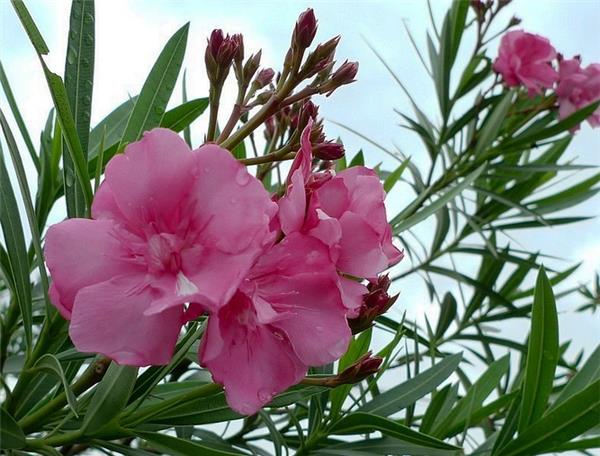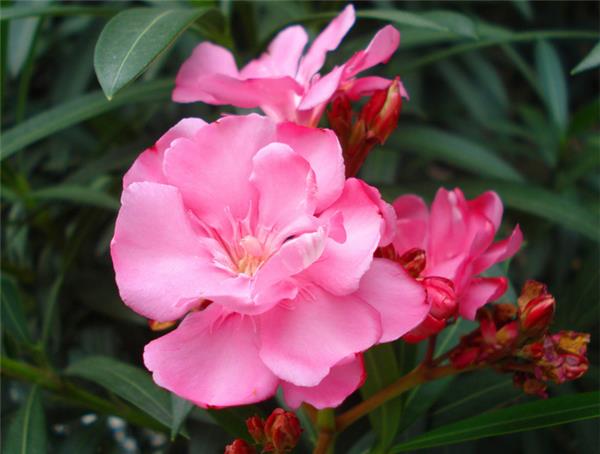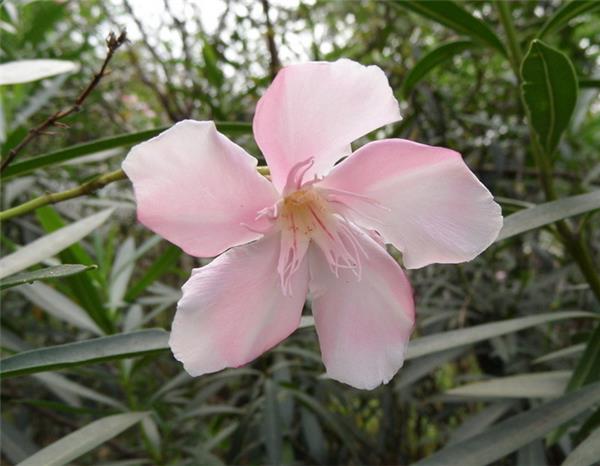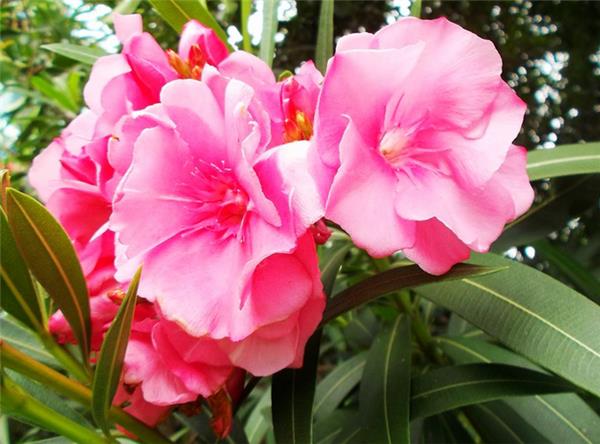The function of plant oleander
Oleander is a very famous flower plant, but many people know that oleander has a certain toxicity, so what are the functions of oleander?

The function of plant oleander
1. Watch
Oleander leaves such as willow bamboo, red flowers burning, better than peach blossoms, Corolla pink to crimson or white, with a special aroma, flowering from June to October, is a famous ornamental flower.
2. Purify the air
Oleander has the ability to resist smoke, dust, poison, purify the air and protect the environment. Oleander leaves are toxic to the human body and have strong resistance to harmful gases such as sulfur dioxide, carbon dioxide, hydrogen fluoride and chlorine. According to the determination, the oleander planted in the pot was only slightly damaged at 40 meters from the pollution source, but basically harmless at 170 meters, and could still blossom normally, and the sulfur content in its leaves was more than 7 times higher than that of the uncontaminated ones. Oleander, even if covered with dust, can still grow vigorously, and is called the "guardian of environmental protection".

3. Medicinal use
Modern medical research has proved that oleander leaves contain oleander glycosides, glycosides and other substances, and flowers contain digitalis glycosides, aglycone, peach glycosides and other components. They have significant cardiotonic and diuretic, sweating, emetic and analgesic effects, and their effects are similar to digitalis and belong to chronic cardiotonic glycosides. It is reported that the water decoction of oleander is suitable for heart failure caused by various causes and achieved good results. Oleander bitter cold, toxic, can be used for the treatment of heart disease, heart failure, amenorrhea, can also be used for fall injury, blood stasis swelling pain and other diseases.
4. Industrial raw materials
Oleander seeds contain 58.5% oil and can be pressed to produce lubricating oil.
5. Textile raw materials
The stem bark fiber of oleander is an excellent blending material.
In addition, oleander has a certain toxicity, stems and leaves can be used to make pesticides.

We mentioned above that oleander is poisonous, so what on earth is going on?
Oleander, leaves such as willow bamboo, red flowers burning, better than peach blossoms, Corolla pink to crimson or white, with a special aroma, flowering from June to October, is a famous ornamental flower. Leaves, bark, roots, flowers and seeds contain a variety of sugars, which are poisonous and can kill people and animals. Cardiotonic agents can be extracted from leaves and stem bark, but they are toxic and should be used with caution. Oleander leaves have strong resistance to sulfur dioxide, carbon dioxide, hydrogen fluoride, chlorine and other toxic and harmful gases.
Oleander-the whole plant is highly toxic (oleander has a strong ability to absorb dust-like Egyptian poisonous gases). It is dangerous for people and animals to eat by mistake, so planting near wells and drinking pools should be avoided. The flower fragrance of oleander can make people drowsy and reduce intelligence. The milky white liquid secreted by stem and leaf bark, flowers and fruits all contain a highly toxic substance called bamboo fungus, which can easily cause cancer of respiratory tract and digestive system if exposed too much. But a small amount of short-term contact won't be much of a problem.
The toxicity of oleander leaves and petals is not great, but the milky liquid exudated from the stems and roots of oleander is more toxic. We found that this milky liquid contains a variety of cardiotonic glycosides, which can cause nausea, vomiting, abdominal pain, diarrhea, abnormal heart rate and death in severe cases.
So oleander is toxic, at present, there is no specific detoxification drugs for symptomatic treatment, such as infusion, detoxification, cardiotonic and supplementary nutrition and other comprehensive measures. The roots, stems, leaves and flowers of oleander are all poisonous, but they are not toxic, so it doesn't matter if you don't eat them or eat a small amount of them.

Pregnant women in the family are not allowed to raise oleander because:
1. Poisoning caused by accidental consumption of oleander leaves or stems. Oleander leaves are used as cardiotonic agents in the clinical treatment of heart disease. It is also an abortion medicine, using its leaves as an decoction for pregnant women to drink, can cause strong uterine contraction, not conducive to the fetus, can cause abortion. One of the ancient solutions to abortion in the past was the use of oleander. However, this method is very prone to accidents, because the dose is difficult to control, and if excessive, it will involve heart and respiratory paralysis, resulting in death.
2. Oleander is poisonous and not easy to be touched by pregnant women. The flowers of bamboo and peach are bright and easy to cultivate. However, its leaves, skins, flowers and fruits all contain a highly toxic substance called Phylloside, which can cause poisoning, lethargy, mental retardation, nausea and dizziness when eaten by pregnant women. It can also have an adverse effect on the fetus.
So for the good of pregnant women and babies at home, it is best to stay away from oleander.
It can also have an adverse effect on the fetus.
So for the good of pregnant women and babies at home, it is best to stay away from oleander.
Related
- Wuhan Hospital Iron Tree Blooming Result Was Instantly Frightened by the Gardener Master
- Which variety of camellia is the most fragrant and best? Which one do you like best?
- What is the small blue coat, the breeding methods and matters needing attention of the succulent plant
- Dormancy time and maintenance management of succulent plants during dormancy
- Minas succulent how to raise, Minas succulent plant pictures
- What are the varieties of winter succulent plants
- How to raise succulent plants in twelve rolls? let's take a look at some experience of breeding twelve rolls.
- Attention should be paid to water control for succulent plants during dormant period (winter and summer)
- Watering experience of twelve rolls of succulent plants
- Techniques for fertilizing succulent plants. An article will let you know how to fertilize succulent plants.



